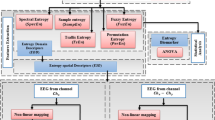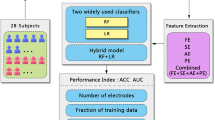Abstract
In recent years, with the rapid development of brain-computer interface (BCI) technology, various applications based on BCI have generated significant interest. A motivating application of BCI is predicting human gender by electroencephalogram (EEG) analysis. However, most of the recent researches only identify the gender of EEG in the resting state. In real-life practice, it is difficult for the subjects to be at a full resting state when it mixes with motor imagery (MI). Therefore, we acquired two kinds of EEG activities data including 9 subjects (5 males and 4 females) with two state (i.e., resting state and MI) based on Chinese sign language. In this paper, to recognize gender form two state, an improved adaptive variational mode decomposition with long short term memory (AVMD-LSTM) network is developed to construct a hybrid state learning framework. Besides, the sample entropy (SE) is employed to select the channel of EEG data as the input of AVMD-LSTM. The recognition accuracy of gender classification was 89.21\(\%\). Comparing with the task of complete resting state, the model is validated with more robustness. Furthermore, the proposed algorithm has many applications, including biometrics, healthcare, and online entertainment advertising.
Supported by the National Natural Science Foundation of China under Grant 61876082, 61861130366, 61732006 and National Key R&D Program of China under Grant 2018YFC2001600, 2018YFC2001602. Thanks to Chinese sign language teacher Yinling Du for providing guidance.
Access this chapter
Tax calculation will be finalised at checkout
Purchases are for personal use only
Similar content being viewed by others
References
Gao, S.K., Wang, Y.J., Gao, X.R., et al.: Visual and auditory brain-computer interfaces. IEEE Trans. Biomed. Eng. 61(5), 1436–1447 (2014)
Lu, N., Li, T., Ren, X., Miao, H.: A deep learning scheme for motor imagery classification based on restricted boltzmann machines. IEEE Trans. Neural Syst. Rehab. Eng .25(6), 566–576 (2017)
Kauhanen, L., Nykopp, T., Lehtonen, J., et al.: EEG and MEG brain-computer interface for tetraplegic patients. IEEE Trans. Neural Syst. Rehab. Eng. 14(2), 190–193 (2006)
Mestais, C.S., Charvet, G., Sauter-Starace, F., Foerster, M., Ratel, D., Benabid, A.L.: WIMAGINE: wireless 64-Channel ECoG recording implant for long term clinical applications. IEEE Trans. Neural Syst. Rehab. Eng. 23(1), 10–21 (2015)
Yuan, K., et al.: Interhemispheric functional reorganization and its structural base after BCI-Guided upper-limb training in chronic stroke. IEEE Trans. Neural Syst. Rehab. Eng. 28(11), 2525–2536 (2020)
Han, C.-H., Müller, K.-R., Hwang, H.-J.: Enhanced performance of a brain switch by simultaneous use of EEG and NIRS Data for asynchronous brain-computer interface. IEEE Trans .Neural Syst. Rehab. Eng. 28(10), 2102–2112 (2020)
Li, J., Yu, Z.L., Gu, Z., Wu, W., Li, Y., Jin, L.: A hybrid network for ERP detection and analysis based on restricted Boltzmann machine. IEEE Trans. Neural Syst. Rehab. Eng. 26(3), 563–572 (2018)
Nakanishi, M., Wang, Y., Chen, X., et al.: Enhancing detection of SSVEPs for a high-speed brain speller using task-related component analysis. IEEE Trans. Biomed. Eng. 65(1), 104–112 (2018)
He, B., Baxter, B., Edelman, B.J., Cline, C.C., Ye, W.W.: Noninvasive brain-computer interfaces based on sensorimotor rhythms. Proceed. IEEE 103(6), 907–925 (2015)
Luders, E., et al.: Gender differences in cortical complexity. Nat. Neurosci. 7(8), 799–800 (2004)
Chao, Z., et al.: Functional connectivity predicts gender: evidence for gender differences in resting brain connectivity. Human Brain Map. 39(3), 1–11 (2018)
Ritchie, S.J., et al.: Sex differences in the adult human brain evidence from 5216 UK biobank participants. Cerebr. Cortex 28(8), 2959–2975 (2018)
Ruigrok, A.N.V., et al.: A meta analysis of sex differences in human brain structure. Neurosci. Biobehav. Rev. 39(1), 34–50 (2014)
Ingalhalikar, M., Smith, A., Parker, D., et al.: Sex differences in the structural connectome of the human brain. Proceed. National Acad. Sci. United States Am. 2(111), 823–828 (2014
Jung, M., Choi, M., Lee, T.R.: Determinants of public phobia about infectious diseases in south korea effect of health communication and gender difference. Asia Pac. J. Public Health 27(2), 1–12 (2015)
Kwon, N., Song, H.: Personality traits gender and information competency among college students. Malaysian J. Library Inf. Sci. 16(1), 87–107 (2011)
Eidinger, E., et al.: Age and gender estimation of unfiltered faces. IEEE Trans. Inf. Forensics Secur. 9(12), 2170–2179 (2014)
Volosyak, I., Valbuena, D., Luth, T., Malechka, T., Graser, A.: BCI demographics II how many (and What Kinds of) people can use a high-frequen cy SSVEP BCI. IEEE Trans. Neural Syst. Rehab. Eng. 19(3), 232–239 (2011)
Raghavan, P., et al.: The role of robotic path assistance and weight support in facilitating 3D movements in individuals with oststroke Hemiparesis. Neurorehab. Neural Repair 34(2), 1–12 (2020)
Sun, Y., Zhang, M., Sun, Z., et al.: Demographic analysis from biometric data: achievements, challenges, and new frontiers. IEEE Trans. Pattern Anal. Machine Intell. 40(2), 332–351 (2018)
Hu, J.: An approach to EEG-based gender recognition using entropy measurement methods. Knowl. Based Syst. 140(15), 134–141 (2018)
Wang, P., Hu, J.: A hybrid model for EEG-based gender recognition. Cognit. Neurodynam. 13(6), 541–554 (2019). https://doi.org/10.1007/s11571-019-09543-y
Kaushik, P., et al.: EEG-Based age and gender prediction using deep BLSTM-LSTM network model. IEEE Sensors J. 19(7), 2634–2641 (2019)
Catrambone, V., Greco, A., Averta, G., Bianchi, M., Valenza, G., Scilingo, E.P.: Predicting object-mediated gestures from brain activity: an EEG study on gender differences. IEEE Trans. Neural Syst. Rehab. Eng. 27(3), 411–418 (2019)
Kaur, B., Singh, D., Roy, P.P.: Age and gender classification using brain-computer interface. Neural Comput. Appl. 31, 5887–5900 (2019)
Cao, Z., Lin, C.-T.: Inherent fuzzy entropy for the improvement of EEG complexity evaluation. IEEE Trans. Fuzzy Syst. 26, 1032–1035 (2018)
Subasi, A., Jukic, S., Kevric, J.: Comparison of EMD, DWT and WPD for the localization of Epileptogenic Foci using random forest classifier. Measurement 146, 846–855 (2019)
Dora, C., Biswal, P.K.: An improved algorithm for efficient ocular artifact suppression from frontal EEG electrodes using VMD. Biocybern. Biomed. Eng. 40(1), 148–161 (2019)
Xia, L., et al.: An improved shuffled frog-leaping algorithm with extremal optimisation for continuous optimisation. Inf. Sci. 192, 143–151 (2012)
Hu, B., et al.: Feature selection for optimized high-dimensional biomedical data using an improved shuffled frog leaping algorithm. IEEE/ACM Trans. Comput. Biol. Bioinf. 15(6), 1765–1773 (2018)
Fan, et al.: Self-adaptive kernel K-means algorithm based on the shuffled frog leaping algorithm. Soft Comput. Fusion Foundations Methodol. Appl. 22(3), 861–872 (2018)
Rajamohana, S.P., Umamaheswari, K.: Hybrid approach of improved binary particle swarm optimization and shuffled frog leaping for feature selection. Comput. Electric. Eng. 67, 497-508 (2018)
Huang, C., et al.: A new pulse coupled neural network (PCNN) for brain medical image fusion empowered by shuffled frog leaping algorithm. Front. Neurosci. 13, 210 (2019)
Rehman, N.U., Aftab, H.: Multivariate variational mode decomposition. IEEE Trans. Signal Process. 67(23), 6039–6052 (2019)
Taran, S., Bajaj, V.: Clustering variational mode decomposition for identification of focal EEG signals. IEEE Sensors Lett 2(4), 1–4 (2018)
Author information
Authors and Affiliations
Corresponding author
Editor information
Editors and Affiliations
Rights and permissions
Copyright information
© 2021 Springer Nature Switzerland AG
About this paper
Cite this paper
Wang, P., Zhou, Y., Li, Z., Zhang, D. (2021). GBCI: Adaptive Frequency Band Learning for Gender Recognition in Brain-Computer Interfaces. In: Fang, L., Chen, Y., Zhai, G., Wang, J., Wang, R., Dong, W. (eds) Artificial Intelligence. CICAI 2021. Lecture Notes in Computer Science(), vol 13069. Springer, Cham. https://doi.org/10.1007/978-3-030-93046-2_19
Download citation
DOI: https://doi.org/10.1007/978-3-030-93046-2_19
Published:
Publisher Name: Springer, Cham
Print ISBN: 978-3-030-93045-5
Online ISBN: 978-3-030-93046-2
eBook Packages: Computer ScienceComputer Science (R0)




